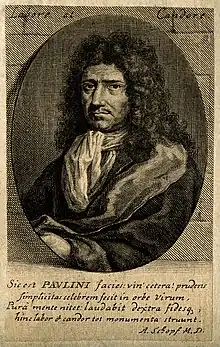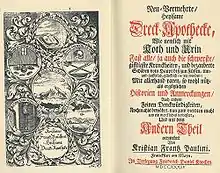Christian Franz Paullini
Christian Franz Paullini (25 February 1643 – 10 June 1712) was a German physician and theologian.

Biography
He was born in Eisenach in a family of merchants and scholars: his parents wanted him to become a priest and his initial education was designed with this in mind. But he was attracted to medical art and studied both theology and medicine.[1]
He attended middle school and secondary school in Thuringia and he graduated from Coburg.
He studied theology and medicine in Gdańsk, Königsberg, Rostock, Lübeck, Kiel and Copenhagen, was Magister Artium in Wittenberg and received his MD in Leiden. Meanwhile, he accomplished study stays and courses in Cambridge, Oxford, Sweden, Norway et Island. He was the Munster Bishop physician and later the Duke of Brunswick physician in Wolfenbüttel.
He came back in Eisenach on 1685 and 1689 where he assumed the position of "Ducal Stadtphysicus" i.e. city doctor.
He was regarded as a polymath and he corresponded with Leibniz[2] and knew the German Jesuit scholar Athanasius Kircher. He was a member of numerous learned societies such as Fruitbearing Society, Pegnesischer Blumenorden and German Academy of Sciences Leopoldina.
In his long life of approximately 70 years, he wrote 68 books of which several editions were printed.
He died in 1712 in his home town.
Works

He made extensive reference and resorted to both ancient and contemporary medical authorities and to folk medicine (sailors, farmers, common people). His works reflected a deep learning based on the four temperaments theory and the outcome of a lengthy process of compiling the data obtained from his observation.
Amongst his essential works, there was a textbook on how to use human and animal excrement to cure internal or external diseases (Heilsame Dreck-Apotheke: wie nemlich mit Koth und Urin die meisten Krankheiten und Schäden glucklich geheilet worden), such as fecal bacteriotherapy.[3][4]
He wrote a treatise (Flagellum salutis) on the advantage of the whip for curative purpose in various disorders and a handbook on the toad's therapeutic properties (Bufo juxta methodum et leges illustris Academiae Naturae curiosorum breviter descriptus).
As a botanist, he gave his name to Paullinia cupana known as guarana, a climbing plant native to the Amazon basin and especially common in Brazil. As a zoologist, he described the kraken in 1706 after Francesco Negri in Animalia fabulosa.[5]
His commitment to promoting religious freedom was far ahead of his time.[6]
In the same way, Christian Franz Paullini bolstered support for women's education by publishing his works in favor of learned German ladies in 1705[7] and in 1712.[8] In his book he listed alphabetically all the learned German women known to him.[9]
His poor reputation came 130 years after his death from false historiographies: Rerum et antiquitatum Germanicarum Syntagma, Chronicon Mindense,[10] Chronicon Hüxariense, Carmen de Brunsburgo and Annales Corbeienses.[11]
Bibliography
- "Cynographia Curiosa Seu Canis Descriptio". WDB – Wolfenbütteler Digitale Bibliothek. 1685.[12]
- Discursus hist. pol. de advocatis et oeconomis monasticis: innexis aliquot diplomatibus et literis vere authenticis. Gollner. 1686. p. 31.
- Bufo juxta methodum & leges illustris Academiae Naturalis Curiosorum breviter descriptus, multisque naturae & artis observationibus, aliisque utilibus curiositatibus, studiosè refertus, à Christiano Francisco Paullini, . (in Latin). impensis Johannis Zigeri, bibliopolae. Typis Christiani Sigismumdi Frobergii. 1686. p. 120.
- Sacra herba, seu nobilis salvia, juxta methodum et leges illustris academiae naturae curiosorum descripta, selectisque remediis, et propriis observationibus conspersa. Augustae Vindelicorum (Augsburg): Laurentii Kronigeri & Theoph. Goebelii. Haeredum Typis Cafpari Brechenmacheri. 1688. p. 414. Archived from the original on 29 June 2013. on the properties of Sage.
- Coenarum Helena, seu Angvilla 1689 by the University and State Library Düsseldorf
- Flagellum salutis: Das ist: Curieuse Erzählung, Wie mit Schlägen Allerhand schwere Kranckheiten ... curiret werden ... Knochen. 1698.
- Rerum et antiquitatum Germanicarum syntagma: varios annales, chronica et dissertationes comprendens ... Knoch. 1698. p. 1033.
- Henricus Graunius; Christian Knauthen (1699). Gaeographia curiosa, seu de pagis antiquae praesertim Germaniae commentarius. Impensis Friderici Knochii.
- Philosophischer Feyerabend: in sich haltende allerhand anmuthige, seltene, curieuse, so nütz als ergetzliche, auch zu allerlei nachtrücklichen Discursen anlassgebende Realien und merckwürdige Begebenheiten, in Leyd und Freud, zumlustigen end erbaulichen Zeitvertreib wohlmeinend mitgetheilet. In Verlegung Fridrich Knochens. 1700. p. 892.
- De Theriaca Coelesti Reformata Liber Singularis: Secundùm Leges & Methodum Imperialis Academiae Leopoldinae Nat. Curiosor. scriptus, Multisque observationibus rarioribus Physico-Medicis illustratus & confirmatus. Knochius. 1701. p. 347.
- "De Candore Liber Singularis, Varijs Antiquitatibus, memorabilibus & curiositatibus illustratus". WDB – Wolfenbütteler Digitale Bibliothek. 1703.
- Paullini, Christian Franz (1704). Nucis moschatae curiosa descriptio.
- Paullini, Christian Franz (1707). Philosophische Lust-Stunden.
- "Die heylsame Dreck-Apotheke" 1714 (remastered) by the University and State Library Düsseldorf
References
- Henri Leclerc (1924). "Christian-François Paullini et son étude sur le crapaud" (in French). Bulletin de la Société d'histoire de la pharmacie. Retrieved 24 May 2013.
- Gottfried Wilhelm Leibniz (1691–1692). Letters. Akademie Verlag. pp. 16 and 556. ISBN 978-3-05-001888-1.
- "Clostridium difficile Linked to Disrupted Gut Microbiota". Archived from the original on 4 July 2013. Retrieved 27 May 2013.
- Steven Lehrer (2013). "Duodenal infusion of feces for recurrent Clostridium difficile". N Engl J Med. 368 (22): 2144. doi:10.1056/NEJMc1303919. PMID 23718172.
- Sir Joseph Banks (1796). Catalogus bibliothecæ historico-naturalis Josephi Banks. Auctore Jona Dryander. typis Gul. Bulmer et Soc. Retrieved 27 May 2013.
- Christian Franz Paullini (1695). Zeit-kürtzende Erbauliche Lust, oder Allerhand außerlesene rar- und curiose, so nütz- als ergetzliche Geist- und Weltliche Merckwürdigkeiten. Knoch.
- Christian Franz Paullini (1705). Das hoch- und wohl-gelahrte teutsche Frauen-Zim̄er. Stößel. pp. 3–.
- Christian Franz Paullini (1712). Hoch- und Wohl-gelahrtes teutsches Frauenzimmer: Abermahl durch Hinzusetzung unterschiedlicher Gelehrter, wie auch etlicher ausländischer Damen hin und wieder um ein merckliches vermehret. Stößel. pp. 1–.
- Bolter, Christina (2002). University of Hawaii (ed.). Dorothea Erxleben: Eighteenth-Century Role Model for today's working Parent.
- Hermann Lövinson (1890). Die Mindensche Chronik des Busso Watensted, eine Fälschung Paullinis (in German). Paderborn : Schöningh.
- Johannes Karl Martin Backhaus (1905). Die Corveyer geschichtsfälschungen des 17. und 18. jahrhunderts: Paullini. Druck der Aschendorffschen buchhandlung. Retrieved 27 May 2013.
- Alex Boese (26 September 2011). "The Egg-Laying Dog of Vienna". Museum of Hoaxes.
Further reading
| Wikimedia Commons has media related to Christian Franz Paullini. |
- "Christian Franz Paullini Biographische Angaben" (PDF) (in German).
- "Publications by or about Christian Franz Paullini on German National Databases".
- "Publications by or about Christian Franz Paullini at Deutschen Nationalbibliothek" (in German).
- "Digitized prints in the catalogue of the Herzog August library". –
- "Hermannus de Bortfeld in the Repertory of "Historical sources of the German middle ages"". (falsification of Paullini)